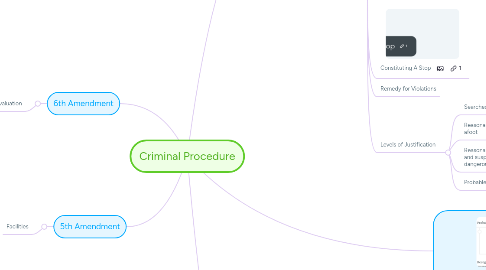
1. 6th Amendment
1.1. Method of Evaluation
2. 5th Amendment
2.1. Facilities
3. Warrantless Search Exceptions
4. 4th Amendment
4.1. Amendment Language
4.1.1. The right of the people to e secure in their persons, houses, papers, and effects; against unreasonable searches and seizures, shall not be violated; and no warrants shall issue, but upon probable cause, supported by an oath or affirmation, and particularly describing the place to be searched and the persons or things to be seized.
4.2. Applies when a (1) citizen manifested an expectation of privacy (2) the expectation is objectively reasonable according to society
4.3. Expectation of Privacy
4.4. Requirements of the 4th Amendment
4.4.1. Police must have justification before conducting a search & seizure
4.4.2. Probable cause is explicitly listed, but reasonableness clause modifies to fit different forms of police actions
4.4.3. Requisite justification is tied to the scope and degree of the intrusion
4.4.3.1. ^ intrusion = ^ cause to show
4.4.3.2. Degree of Justification
4.5. Using Warrants
4.5.1. Components of a valid Warrant
4.5.1.1. Neutral and Detached Magistrate
4.5.1.2. Particularity
4.5.1.3. Probable cause with support by oath, affirmation or affidavit
4.6. Constituting A Stop
4.7. Remedy for Violations
4.8. Levels of Justification
4.8.1. Searches Requiring no justification
4.8.2. Reasonable suspicion criminal activity is afoot
4.8.3. Reasonable suspicion of criminal activity and suspect may possess potentially dangerous weapon
4.8.4. Probable Cause
